2017 Hyundai Elantra ESP
[x] Cancel search: ESPPage 19 of 571
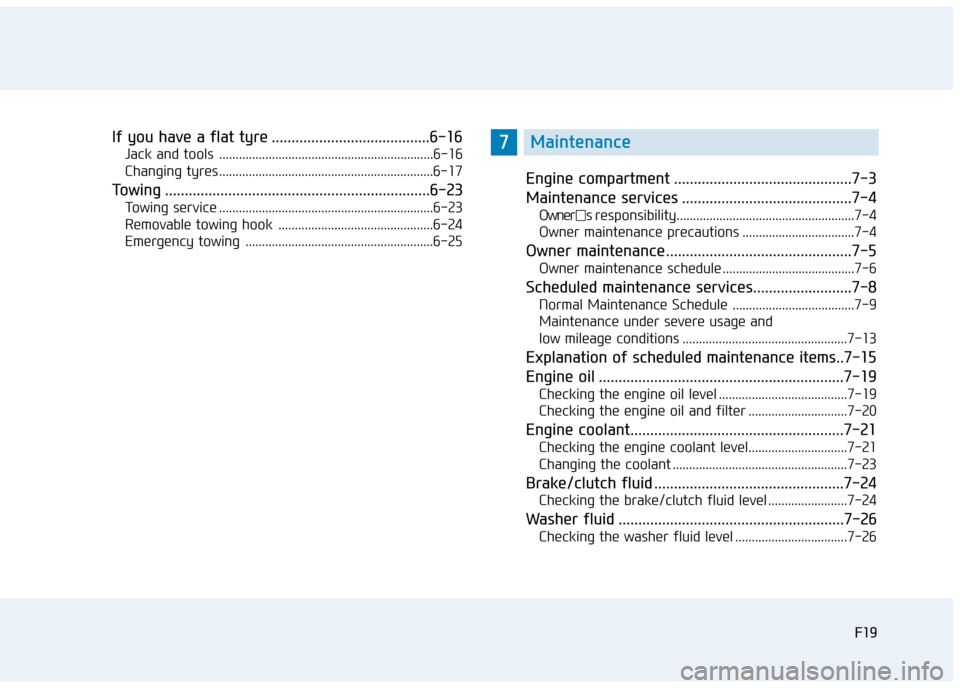
F19
If you have a flat tyre ........................................6-16
Jack and tools .................................................................6-16
Changing tyres .................................................................6-17
To w i n g . . . . . . . . . . . . . . . . . . . . . . . . . . . . . . . . . . . . . . . . . . . . . . . . . . . . . . . . . . . . . . . . . . . 6 - 2 3
To w i n g s e r v i c e . . . . . . . . . . . . . . . . . . . . . . . . . . . . . . . . . . . . . . . . . . . . . . . . . . . . . . . . . . . . . . . . . 6 - 2 3
Removable towing hook ...............................................6-24
Emergency towing .........................................................6-25
Engine compartment .............................................7-3
Maintenance services ...........................................7-4
Owner�s responsibility......................................................7-4
Owner maintenance precautions ..................................7-4
Owner maintenance ...............................................7-5
Owner maintenance schedule ........................................7-6
Scheduled maintenance services.........................7-8
Normal Maintenance Schedule .....................................7-9
Maintenance under severe usage and
low mileage conditions ..................................................7-13
Explanation of scheduled maintenance items..7-15
Engine oil ..............................................................7-19
Checking the engine oil level .......................................7-19
Checking the engine oil and filter ..............................7-20
Engine coolant......................................................7-21
Checking the engine coolant level..............................7-21
Changing the coolant .....................................................7-23
Brake/clutch fluid ................................................7-24
Checking the brake/clutch fluid level ........................7-24
Washer fluid .........................................................7-26
Checking the washer fluid level ..................................7-26
F19
7Maintenance
Page 29 of 571
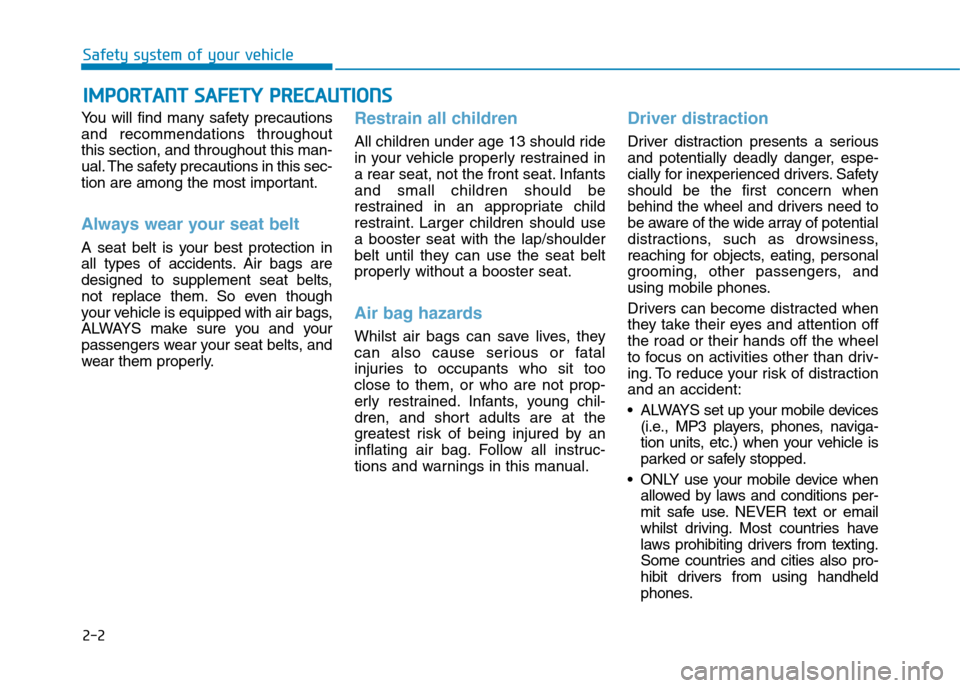
2-2
Yo u w i l l f i n d m a n y s a f e t y p r e c a u t i o n s
and recommendations throughout
this section, and throughout this man-
ual. The safety precautions in this sec-
tion are among the most important.
Always wear your seat belt
A seat belt is your best protection in
all types of accidents. Air bags are
designed to supplement seat belts,
not replace them. So even though
your vehicle is equipped with air bags,
ALWAYS make sure you and your
passengers wear your seat belts, and
wear them properly.
Restrain all children
All children under age 13 should ride
in your vehicle properly restrained in
a rear seat, not the front seat. Infants
and small children should be
restrained in an appropriate child
restraint. Larger children should use
a booster seat with the lap/shoulder
belt until they can use the seat belt
properly without a booster seat.
Air bag hazards
Whilst air bags can save lives, they
can also cause serious or fatal
injuries to occupants who sit too
close to them, or who are not prop-
erly restrained. Infants, young chil-
dren, and short adults are at the
greatest risk of being injured by an
inflating air bag. Follow all instruc-
tions and warnings in this manual.
Driver distraction
Driver distraction presents a serious
and potentially deadly danger, espe-
cially for inexperienced drivers. Safety
should be the first concern when
behind the wheel and drivers need to
be aware of the wide array of potential
distractions, such as drowsiness,
reaching for objects, eating, personal
grooming, other passengers, and
using mobile phones.
Drivers can become distracted when
they take their eyes and attention off
the road or their hands off the wheel
to focus on activities other than driv-
ing. To reduce your risk of distraction
and an accident:
•ALWAYS set up your mobile devices
(i.e., MP3 players, phones, naviga-
tion units, etc.) when your vehicle is
parked or safely stopped.
•ONLY use your mobile device when
allowed by laws and conditions per-
mit safe use. NEVER text or email
whilst driving. Most countries have
laws prohibiting drivers from texting.
Some countries and cities also pro-
hibit drivers from using handheld
phones.
IIMMPPOORRTTAANNTT SSAAFFEETTYY PPRREECCAAUUTTIIOONNSS
Safety system of your vehicle
Page 30 of 571

2-3
Safety system of your vehicle
•NEVER let the use of a mobile
device distract you from driving. You
have a responsibility to your passen-
gers and others on the road to
always drive safely, with your hands
on the wheel as well as your eyes
and attention on the road.
Control your speed
Excessive speed is a major factor in
crash injuries and deaths. Generally,
the higher the speed, the greater the
risk, but serious injuries can also
occur at lower speeds. Never drive
faster than is safe for current condi-
tions, regardless of the maximum
speed posted.
Keep your vehicle in a safe con-
dition
Having a tyre blowout or a mechanical
failure can be extremely hazardous. To
reduce the possibility of such prob-
lems, check your tyre pressures and
condition frequently, and perform all
regularly scheduled maintenance.
2
Page 33 of 571

2-6
Safety system of your vehicle
Seat belts
Always fasten your seat belt before
starting any trip.
At all times, passengers should sit
upright and be properly restrained.
Infants and small children must be
restrained in appropriate child restraint
systems. Children who have outgrown
a booster seat as well as adults, must
be restrained using the seat belts.
Front seats
The front seat can be adjusted by
using the control switches located on
the outside of the seat cushion. Before
driving, adjust the seat to the proper
position so that you can easily control
the steering wheel, foot pedals and
controls on the instrument panel.
Ta k e t h e f o l l o w i n g p r e c a u t i o n s
when adjusting your seat belt:
•NEVER use one seat belt for
more than one occupant.
•Always position the seatback
upright with the lap portion of
the seat belt snug and low
across the hips.
•NEVER allow children or
small infants to ride in a pas-
senger’s lap.
•Do not route the seat belt
across your neck, across
sharp edges, or reroute the
shoulder strap away from
your body.
•Do not allow the seat belt to
become caught or jammed.
WA R N I N G
Ta k e t h e f o l l o w i n g p r e c a u t i o n s
when adjusting your seat:
•NEVER attempt to adjust the
seat whilst the vehicle is mov-
ing. The seat could respond
with unexpected movement
and may cause loss of vehicle
control resulting in an acci-
dent.
•Do not place anything under
the front seats. Loose objects
in the driver’s foot area could
interfere with the operation of
the foot pedals, causing an
accident.
(Continued)
WA R N I N G
Page 42 of 571

2-15
Safety system of your vehicle
2
Headrest
The vehicle’s front and rear seats
have adjustable headrests. The head-
rests provide comfort for passengers,
but more impor tantly they are
designed to help protect passengers
from whiplash and other neck and
spinal injuries during an accident,
especially in a rear impact collision.
To p r e v e n t d a m a g e , N E V E R h i t o r
pull on the headrests.
NOTICE(Continued)
•
Adjust the headrests so the
middle of the headrest is at the
same height as the height of
the top of the eyes.
•NEVER adjust the headrest
position of the driver’s seat
when the vehicle is in motion.
•Adjust the headrest as close
to the passenger’s head as
possible. Do not use a seat
cushion that holds the body
away from the seatback.
•Make sure the headrest locks
into position after adjusting it.
OLF034072N
To r e d u c e t h e r i s k o f s e r i o u s
injury or death in an accident,
take the following precautions
when adjusting your headrests:
•Always properly adjust the
headrests for all passengers
BEFORE starting the vehicle.
•NEVER let anyone ride in a seat
with the headrest removed.
(Continued)
WA R N I N G
When there are no occupants in
the rear seats, adjust the height
of the headrests to the lowest
position. The rear seat head-
rests can reduce the visibility of
the rear area.
CAUTION
Page 46 of 571
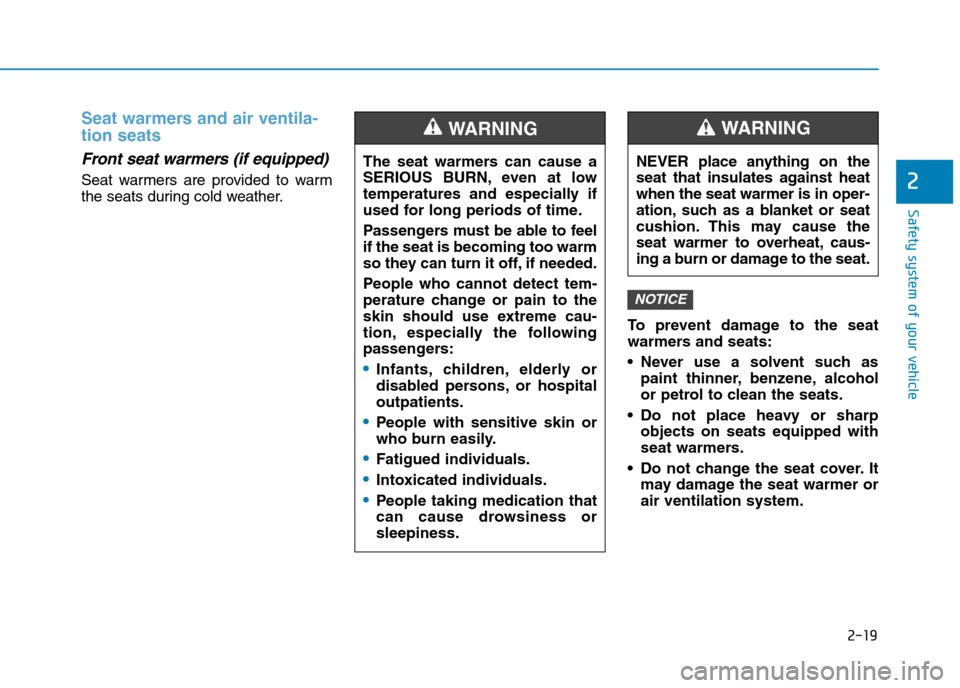
2-19
Safety system of your vehicle
2
Seat warmers and air ventila-
tion seats
Front seat warmers (if equipped)
Seat warmers are provided to warm
the seats during cold weather.
To p r e v e n t d a m a g e t o t h e s e a t
warmers and seats:
•Never use a solvent such as
paint thinner, benzene, alcohol
or petrol to clean the seats.
•Do not place heavy or sharp
objects on seats equipped with
seat warmers.
•Do not change the seat cover.It
may damage the seat warmer or
air ventilation system.
NOTICE
The seat warmers can cause a
SERIOUS BURN, even at low
temperatures and especially if
used for long periods of time.
Passengers must be able to feel
if the seat is becoming too warm
so they can turn it off, if needed.
People who cannot detect tem-
perature change or pain to the
skin should use extreme cau-
tion, especially the following
passengers:
•Infants, children, elderly or
disabled persons, or hospital
outpatients.
•People with sensitive skin or
who burn easily.
•Fatigued individuals.
•Intoxicated individuals.
•People taking medication that
can cause drowsiness or
sleepiness.
WA R N I N G
NEVER place anything on the
seat that insulates against heat
when the seat warmer is in oper-
ation, such as a blanket or seat
cushion. This may cause the
seat warmer to overheat, caus-
ing a burn or damage to the seat.
WA R N I N G
Page 52 of 571
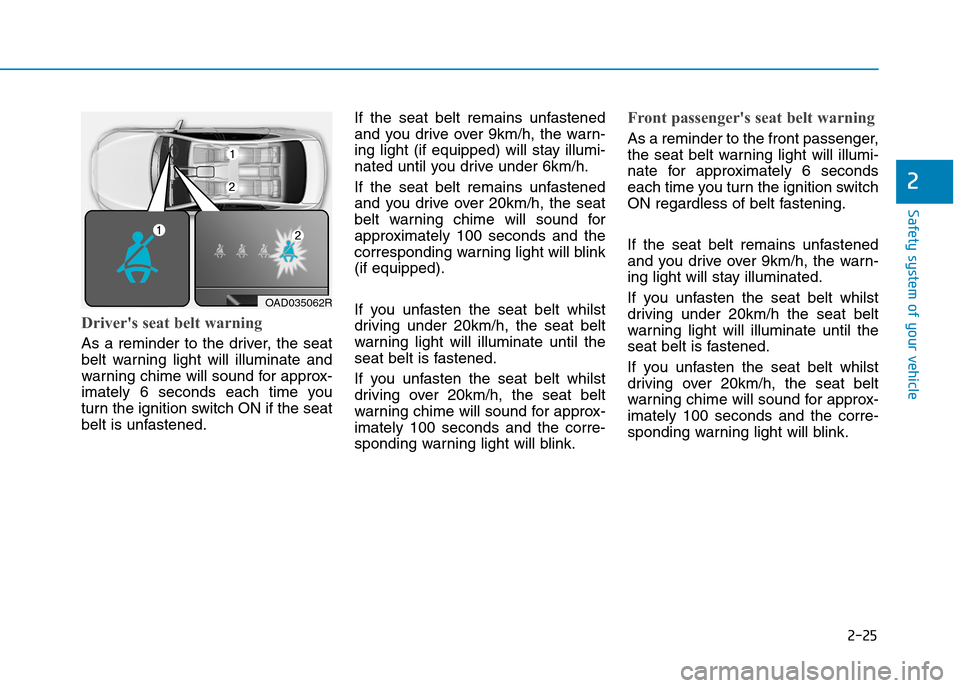
2-25
Safety system of your vehicle
Driver's seat belt warning
As a reminder to the driver, the seat
belt warning light will illuminate and
warning chime will sound for approx-
imately 6 seconds each time you
turn the ignition switch ON if the seat
belt is unfastened.
If the seat belt remains unfastened
and you drive over 9km/h, the warn-
ing light (if equipped) will stay illumi-
nated until you drive under 6km/h.
If the seat belt remains unfastened
and you drive over 20km/h, the seat
belt warning chime will sound for
approximately 100 seconds and the
corresponding warning light will blink
(if equipped).
If you unfasten the seat belt whilst
driving under 20km/h, the seat belt
warning light will illuminate until the
seat belt is fastened.
If you unfasten the seat belt whilst
driving over 20km/h, the seat belt
warning chime will sound for approx-
imately 100 seconds and the corre-
sponding warning light will blink.
Front passenger's seat belt warning
As a reminder to the front passenger,
the seat belt warning light will illumi-
nate for approximately 6 seconds
each time you turn the ignition switch
ON regardless of belt fastening.
If the seat belt remains unfastened
and you drive over 9km/h, the warn-
ing light will stay illuminated.
If you unfasten the seat belt whilst
driving under 20km/h the seat belt
warning light will illuminate until the
seat belt is fastened.
If you unfasten the seat belt whilst
driving over 20km/h, the seat belt
warning chime will sound for approx-
imately 100 seconds and the corre-
sponding warning light will blink.
2
OAD035062R
Page 53 of 571
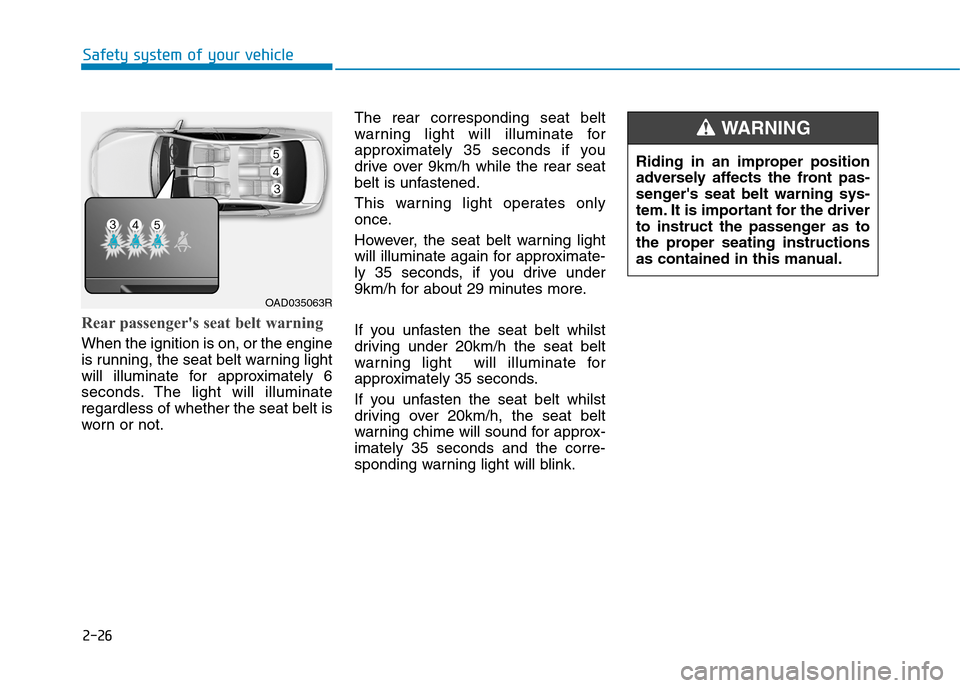
2-26
Rear passenger's seat belt warning
When the ignition is on, or the engine
is running, the seat belt warning light
will illuminate for approximately 6
seconds. The light will illuminate
regardless of whether the seat belt is
worn or not.
The rear corresponding seat belt
warning light will illuminate for
approximately 35 seconds if you
drive over 9km/h while the rear seat
belt is unfastened.
This warning light operates only
once.
However, the seat belt warning light
will illuminate again for approximate-
ly 35 seconds, if you drive under
9km/h for about 29 minutes more.
If you unfasten the seat belt whilst
driving under 20km/h the seat belt
warning light will illuminate for
approximately 35 seconds.
If you unfasten the seat belt whilst
driving over 20km/h, the seat belt
warning chime will sound for approx-
imately 35 seconds and the corre-
sponding warning light will blink.
Safety system of your vehicle
Riding in an improper position
adversely affects the front pas-
senger's seat belt warning sys-
tem. It is important for the driver
to instruct the passenger as to
the proper seating instructions
as contained in this manual.
WA R N I N G
OAD035063R